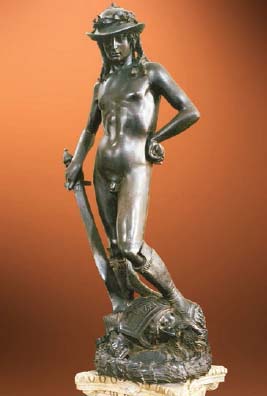The Early Modern World, C. 1300–1600Early Renaissance in Italy |
What is Donatello’s David? |
Donatello (Donato di Niccolo de Betto di Bardi, c. 1386–1466) was considered a genius of the early Renaissance. He had a long career as a sculptor and is responsible for the famous bronze David, the first life-size male nude sculpture made since antiquity. Donatello’s David is surrounded in mystery—art historians do not who the patron was, for example, though it was placed in a courtyard at the Medici palace home of the ruling family in Florence at the time. It is thought that the noble David symbolizes the recent Florentine military victory over neighboring city-state Milan, in 1428. In this piece, Donatello represents this Old Testament hero as a young, nude man in early adolescence. His hips are tilted in a confident contrapposto pose and he stands, with knees slightly bent, over the dismembered head of his foe, Goliath. A large feather from Goliath’s helmet can be seen reaching high up the inside of David’s leg. Donatello’s David is at once a reflection of the Classical tradition of sculpture making, and an erotic depiction of youthful heroism. It is quite different from another famous David done by Michelangelo.

The Renaissance artist Donatello depicts the Old Testament hero David in this figurative bronze from the mid-fifteenth century. Dontello’s youthful David marks the first time a life-size male nude was depicted in bronze since antiquity.
